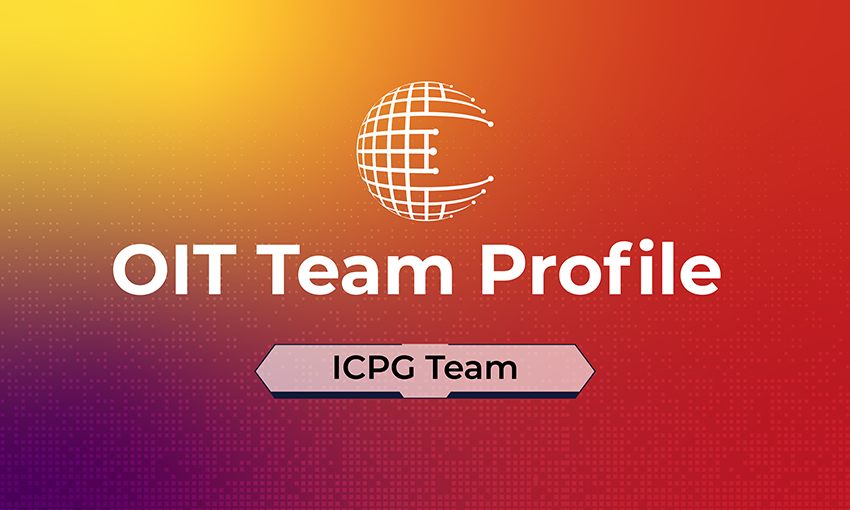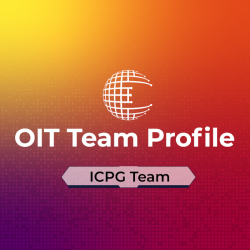Moving Forward Together: Spotlight on ICPG

‘Synergistic’ isn’t simply business lingo for the IT Capital Planning Group (ICPG); it’s the very foundation of the complex services the group delivers. ICPG juggles an intricate ecosystem consisting of the OIT budget, Section 508 compliance, IT resource management, CMS audits, and much more.
Our interview with ICPG reveals a closer look at how this team achieves such synergy and what they hope to accomplish this year.
Tell me about your team’s area of work.
ICPG supports the role of the CIO in Capital Planning and Investment Control (CPIC), including evaluating and assessing how well CMS manages IT resources. We also plan and manage the OIT budget, ensuring business priorities are adequately funded every year. Additionally, we manage the Section 508 Program, providing accessible information and communication technology (ICT) to persons with disabilities.
Tell us about who makes up your team and how you work together.
ICPG has four Divisions:
-
Division of IT Budget Operations
-
Division of Vendor Strategy and Management
-
Division of IT Investment Management & Policy
-
Division of Investment Oversight and Governance
The ICPG Front Office includes an office support assistant, special assistant, and five senior technical advisors (TAs). The senior TAs support ICPG front office efforts and various division-level projects.
One of the most important aspects of how we work together is by developing collaborative relationships. If you don’t develop trust with the people you work with, you won’t succeed in meeting your goals. Trust is particularly important because the type of information we gather isn’t typical mainstream information. We collaborate with components across CMS and strive to develop a good rapport, which allows them to share what’s happening within their teams. Once we understand a team’s projects, we determine potential touchpoints to enable groups to connect and work together on projects.
What’s one interesting thing people should know about your group?
We wear two hats: We support the role of the CIO and the role of the OIT director. The responsibilities for each role differ but they do intersect, which can be challenging.
What are your goals for the year?
ICPG has four goals for the year.
-
Improved transparency around IT spending:
The Division of IT Budget Operations (DIBO) works primarily with OIT Groups, as well as CMS components where applicable, to understand how they spend their dollars. Once we collect budget information, we develop a spending plan for each group that reflects what percent is spent on the cloud, software, etc. This is to encourage transparency, which benefits everyone in CMS. When we can see where money is spent, we can understand how to spend better and meet the needs of OIT as a whole. We also want OIT groups to know we’re here to ensure they’re taking advantage of any existing resources.
-
Increased Section 508 awareness and compliance:
When project teams develop ICT, Section 508 may not be on their radar. ICPG strives to foster a culture of inclusion by ensuring project teams consider Section 508 requirements at the start of development. This enables teams introducing a new IT project to address whether it will be compliant if, for example, the project requires a new or an updated interface. We’ve also launched a lunch-n-learn training series, as well as additional trainings for CMS clearance officers. The Division of Investment Oversight and Governance (DIOG) also connects with teams to ensure their systems are tested and remediated.
Additionally, we support the Section 508 procurement process. We conduct Accessibility Conformance Report (ACR) and Voluntary Product Accessibility Template (VPAT) reviews to assess the level of accessibility conformance during the market research and proposal evaluation stages. We also provide document remediation support to ensure ICT goods and services are accessible to everyone.
-
Data-driven IT decision-making:
When a component has a funding request for a new item or project, they create a business case. We use this data to determine how to best meet the component’s needs. For example, if they need a new website, we assess whether there’s an existing platform that could be used instead of new software. However, spending decisions aren’t always about cost. We also consider what is most secure and usable to the customer. This data helps the Division of IT Investment Management & Policy (DIIMP) determine the best way to meet the component’s needs and get their project approved when it goes before the Governance Review Board.
-
Increased collaboration with OAGM and agency components to improve software spend optimization activities and software asset management capabilities:
Every software contract is awarded by the Office of Acquisition & Grants Management (OAGM). The Division of Vendor Strategy and Management (DVSM) collaborates with OAGM so that we’ll be informed when project teams make software purchases. In doing so, we proactively encourage teams to leverage existing software enterprise licensing agreements instead of buying software through separate contracts. This reduces software cost, tracks spending more efficiently and supports agency category management efforts. Additionally, DVSM tracks agency infrastructure software to further consolidate purchases.
From helping CMS achieve their IT financial needs to resolving accessibility issues and more, ICPG continues to strive for best-in-class service, improved user experience, and efficiency, propelling CMS forward in an ever-evolving world of technological advancements.

